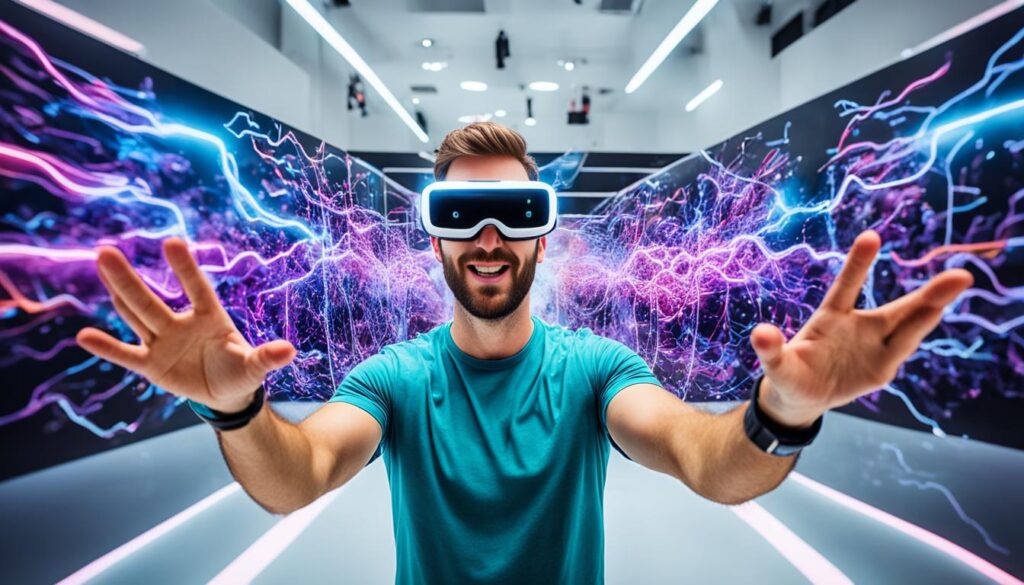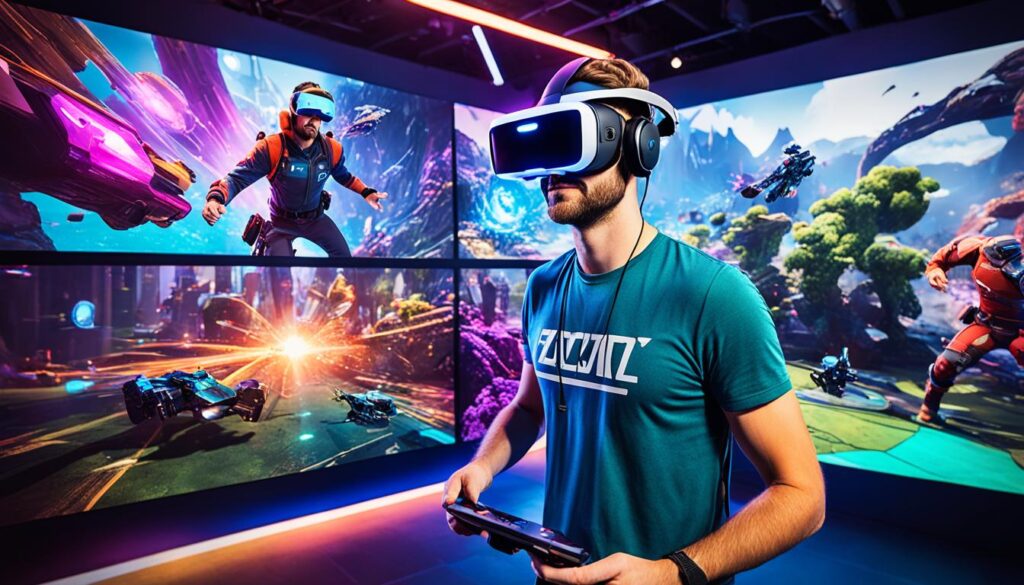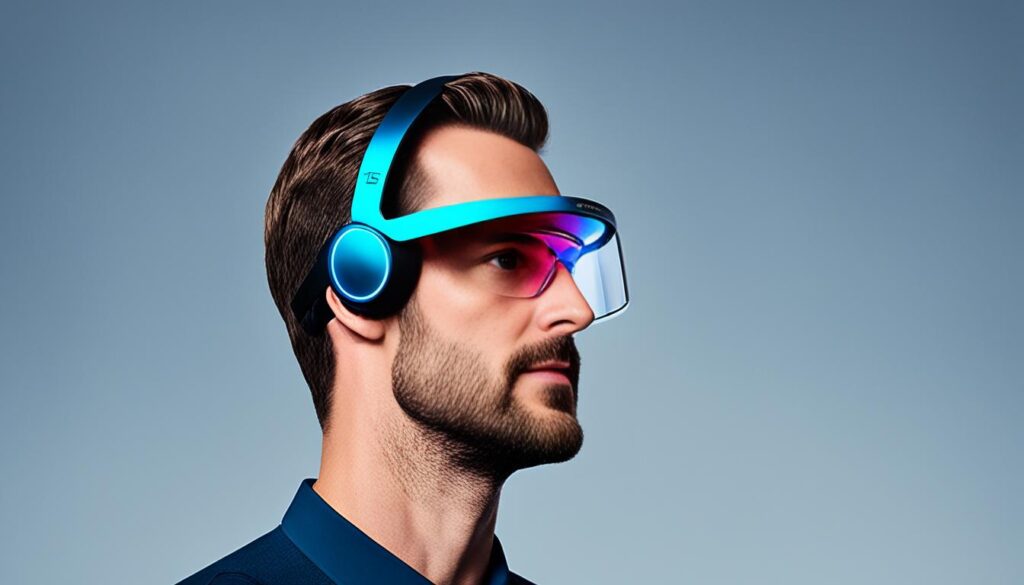Augmented reality (AR) is a new tech that mixes digital visuals and sounds with our real world. It uses holographic tech to make our world more engaging and dynamic. This way, it changes how we see and interact with our environment.
AR is not like virtual reality (VR) which replaces the real world. Instead, AR adds digital content to our real world. This blurs the line between what’s real and what’s not.
This tech lets us touch and change virtual and real things as if they’re right in front of us. It works by mapping objects in 3D, making the experience feel real. This captivates our senses and helps us see our world in new ways.
AR has caught the eye of many businesses. They see its potential to change the way they work. By adding AR, they hope to work better, make customers happier, and find new chances to grow.
Key Takeaways:
- Augmented reality (AR) enhances the real-world environment with digital visual elements and sensory stimuli.
- AR overlays digital content onto our physical surroundings, blending the lines between reality and the virtual world.
- AR enables real-time interaction and accurate 3D identification of virtual and real objects.
- AR is often the easiest of its kind to integrate into business processes.
- AR has the potential to revolutionize industries by improving productivity, enhancing experiences, and unlocking new opportunities.
Types of Augmented Reality
Augmented reality (AR) divides into two main kinds: marker-based AR and marker-less AR. They both use different tech to place virtual things and images in the real world.
Marker-Based AR
Marker-based AR recognizes images and objects to make real life seem better. It uses special markers or objects to figure out where the camera is looking. This lets the AR system put virtual content on the real-world settings.
Imagine using an AR app to see 3D furniture in your home before buying. You’d scan a marker on the floor to get the room’s size right. The app then adds the virtual furniture to the camera view. You can then see how the real furniture will fit in the room.
Marker-Less AR
Marker-less AR doesn’t need markers. It uses special algorithms and camera data to spot objects in view. This kind of AR can put virtual stuff in many different real spaces.
For example, there could be an AR app that reads street signs for you. It uses tech to figure out what the signs say. Then it shows what they mean on your screen. This gives you an extra way to understand your surroundings.
To sum up, both marker-based AR and marker-less AR bring virtual stuff into the real world. Marker-based AR needs markers to work. Marker-less AR doesn’t need markers because it uses clever tech to see the world. Which one to use depends on the job and how you want to mix digital and real worlds.
How Augmented Reality Works
Augmented reality (AR) uses the power of AI and special software. It also needs strong processors, unique lenses, and sensors. This tech mixes virtual things with the real world, making our world look different and interact in new ways.
Utilizing Artificial Intelligence
AI’s smart algorithms play a essential role in AR. They help with everything from giving voice cues to processing data. AI makes sure virtual things attach accurately to real objects, making your AR experience smooth and interactive.
AR Software and Processing Power
AR uses advanced software to process real-world data in real time. Then it turns this data into what you see overlaid on the physical world. Powerful computers are essential for the quick, smooth experience users enjoy.
Lenses and Sensory Sensors
AR uses lenses or screens in gadgets like headsets or phones to let you see virtual objects in your space. These parts are what let you see the AR world around you.
Also, AR comes with many sensors, like cameras and gyroscopes. They pick up real-world info to place virtual items correctly and track them as you move.
An Immersive Experience
Augmented reality combines AI, powerful software, and sensing tech to make an alternative, interactive reality. It helps us experience virtual content as if it’s part of our real surroundings, adding a new layer to our perception.

| Component | Functionality |
|---|---|
| Artificial Intelligence | Enables voice prompts and data processing, ensuring accurate recognition and tracking of objects, and efficient analysis of user input. |
| AR Software and Processing Power | Specialized software processes real-time data, converts it into meaningful information, and overlays virtual elements onto real-world environments. Powerful processing capabilities ensure a smooth user experience. |
| Lenses and Sensory Sensors | Lenses or screens allow users to view and interact with virtual objects, while sensors, including cameras and gyroscopes, capture real-time information about the surroundings, enabling accurate alignment and tracking. |
Augmented reality is changing how we live, work, and play. It’s already transforming industries like games, education, and health. As technology advances, AR’s power to create new, immersive experiences grows.
Integrating AR into Training and Education
Augmented reality (AR) may change how we learn at work and school. It makes learning fun and real through interactive experiences. AR tools make lessons more interesting and effective for everyone.
Enhancing Employee Training
AR tools bring many benefits to training at work. They can:
- Help people do their jobs better by giving real-time advice.
- Make lessons exciting by showing complex ideas in simple ways.
- Make starting a new job easier with interactive tours and help.
- Let employees learn anytime, anywhere, which keeps their skills sharp.
- Teach customer service by simulating talking to real customers and learning how to help them.
Adding AR to training makes learning more engaging and fun. People remember more and use what they learned better.
Industry-Specific Uses
Many fields can benefit from AR, like retail and manufacturing. For instance:
| Industry | AR Uses |
|---|---|
| Retail | Virtual try-on for clothes and accessories, interactive product demonstrations |
| Manufacturing | AR-guided assembly instructions, maintenance and repair support |
| Healthcare | Simulation training for medical procedures, augmented anatomy visualization |
| Military | AR-based combat training simulations, situational awareness enhancement |
| Automobile | AR-powered vehicle design and prototyping, remote assistance for repairs |
AR is not limited to these examples. Every day, new uses for AR in different fields are found.
Introducing AR to training leads to better learning and results. It uses new technology to make lessons interesting and accessible. This approach lets organizations support their teams better and find new paths for learning and growth.
Let’s look closer at how AR benefits different fields and training scenarios.
Advantages and Use Cases of AR
Augmented reality (AR) brings many benefits and thrilling applications to different fields. It changes how we navigate, analyze sports, and shop for furniture. AR also plays a key role in the military, archaeology, entertainment, gaming, and more.
Enhanced Navigation
AR changes the way we find our way around. It adds digital details to the real world, making navigation better. This can be useful when exploring new places or navigating a complex area.
Football Analysis
In sports, AR is used for deep analysis, especially in football. It overlays plays and stats on live games for a comprehensive view. This helps coaches and analysts improve their strategies by understanding the game better.
Virtual Furniture Placement
With AR, placing virtual furniture in your home is easy. This tech turns your space into a showroom, helping you see how items look together. It’s a smart way to shop, reducing guesswork and making decisions simpler.
Military Applications
The military relies on AR for many tasks, from training to live mission support. It gives soldiers critical information in real time, like maps and target locations, boosting their efficiency. This leads to better decisions and smoother operation conduction.
Archaeology
AR has a big role in archaeology, letting researchers explore past sites in a digital form. It helps visualize ancient buildings and artifacts, aiding in historical research. It also offers interactive learning and supports the protection of cultural heritage.
Retail
In retail, AR creates innovative shopping experiences. Customers can virtually try on clothes or see products in their space before buying. It boosts satisfaction, cuts down returns, and increases sales both online and off.
Entertainment and Gaming
Entertainment and gaming are changed by AR, blending the digital with the physical. Games like Pokemon Go are a huge hit, making players explore to find creatures. AR also enhances live experiences like concerts, making them more interactive.

AR is pushing boundaries in many areas, from helping us find our way to making shopping interactive. It has truly changed the way we experience the digital world, with endless possibilities.
Examples of Augmented Reality
Augmented reality (AR) is a versatile technology. It’s used in many practical applications. Let’s look at some cool examples:
1. Target App
The Target app includes an amazing AR feature. It lets you see how furniture looks in your home. Users can check if a piece fits the space and matches the decor.
2. Apple Measure App
The Apple Measure app turns your Apple device into a digital tape measure. With AR, it’s easy to measure items in the real world. This is helpful for things like checking if a new couch fits in your room.
3. Snapchat Filters
Snapchat made a big change in social media with its cool Snapchat filters. These AR filters add fun and creativity to photos and videos. Users love to play with different effects and animations.
4. Pokemon Go
Pokemon Go became a hit in 2016. This game mixes real life with AR. Players find and catch Pokemon in their actual surroundings. It got people outside and exploring to find Pokemon.
5. Google Glass
Google Glass is a revolutionary AR device. It’s like wearing a computer on your face. Users can see digital information in the real world without looking away. It’s hands-free and very advanced.
6. U.S. Army Tactical Augmented Reality
The U.S. Army uses AR in their Tactical Augmented Reality system. It helps soldiers stay aware and make better decisions in the field. This technology is crucial for military success.
7. Apple Vision Pro and Meta Quest 3
The Apple Vision Pro and Meta Quest 3 are top-notch AR and mixed-reality headsets. They offer incredible virtual experiences. Users can interact with digital worlds like never before.
AR has changed the way we shop, play games, and even fight battles. It bridges the gap between the digital and real worlds. AR technology keeps growing, making our lives more interesting and interactive.
The Future of AR Technology
The future of augmented reality (AR) looks bright. Apple and Google are at the forefront of innovation and investment. They’re developing platforms like Apple ARKit and Google ARCore. These platforms are bringing thrilling changes to AR.
The future of AR includes top-notch headsets. These cutting-edge devices give users more real and immersive AR experiences. They offer better visuals, track movement accurately, and are comfortable to wear. This upgrade takes AR to new, exciting levels.

Competition is fierce in the AR world. This pushes companies to keep improving. They aim to offer users the best and most engaging AR adventures. They’re focusing on tracking accuracy and gesture recognition. The goal is to make the best AR tech out there.
Technological growth is key to AR’s future. As our devices get more powerful, AR apps get speedier and smarter. This makes the AR fit into our lives more seamlessly. Also, AI helps AR apps be more intuitive and tailored to us.
Benefits of the Future of AR Technology
AR’s evolution brings big perks to many fields. Here’s how:
- It makes it easier to see and understand in architecture and engineering.
- Helps stores engage with customers better and offer more personal shopping.
- Blends the real and virtual in new ways for fun and games.
- It’s changing healthcare with AR in surgeries and showing patient data.
These are just the start of what AR technology could do. It’s set to change our daily lives in big ways.
| AR Development Platforms | Improved Headsets | Competition | Technological Advancements |
|---|---|---|---|
| Apple ARKit | State-of-the-art devices offering immersive experiences | Driving constant innovation in the AR industry | Advancements in AI and processing power |
| Google ARCore | Advanced visuals and tracking capabilities | Fierce competition pushing the boundaries of AR technology | Improved efficiency and intelligent AR software |
Benefits and Implications of AR
Augmented reality (AR) is changing the game in many fields. It boosts the way users experience things, helps workers be more effective, and opens doors for growth. Discover how AR is shaking things up.
Enhanced User Experience
AR lets users dive into worlds where the real and digital mix seamlessly. It lets you try on clothes virtually or see 3D models of buildings. This not only sparks interest but also leaves a lasting impression.
Improved Productivity
In the workplace, AR can be a game-changer. It puts important information right before employees’ eyes, hands-free. This makes tasks smoother, error-free, and boosts overall work speed. Imagine how fast repairing equipment could be with AR to guide you.
Accessibility
AR is breaking barriers for those with disabilities. It helps the visually impaired navigate better and makes learning more engaging for different students. This means more people can enjoy and use what AR has to offer.
New Opportunities
AR is a goldmine for businesses looking to stand out. It allows virtual product testing before purchase and improves medical training. It’s also changing how we play games and experience entertainment. The chance for growth with AR is enormous.
Impact on Various Industries
AR is transforming how we shop, learn, heal, and even play. It’s making retail more personal, healthcare more precise, and entertainment more immersive. Nearly every industry is finding new ways to work better with AR.
AR is shaping a new world filled with better experiences, working smarter, and bigger growth opportunities. We’re just scratching the surface of what AR can do.
Conclusion
Augmented reality is growing fast. It mixes digital content with the real world, making our experiences better. It’s in use in many fields like training, shopping, and the military. The technology will keep getting better, and we’ll see new and exciting uses.
Today, both people and groups are excited about augmented reality. It joins the virtual world with the world we see. This offers a lot of new chances for us, making things more engaging and useful. AR changes how we use technology, helping us in different ways.
The future of AR looks promising. Big companies are putting money into making AR even better. As they do, we’ll get awesome new features and devices. AR is changing many fields and our everyday life. It shows how powerful technology can be in shaping our future.
FAQ
What is augmented reality?
Augmented reality (AR) makes the real world more interactive through digital elements. It uses tech like holograms to blend the digital and physical worlds. This allows real-time interactions and precise 3D matching of virtual and real items.
What are the types of augmented reality?
AR comes in two main forms: marker-based and marker-less. Marker-based AR recognizes images to know where to place digital content. Marker-less AR spots objects as your view changes, creating seamless virtual overlays.
How does augmented reality work?
To work, AR uses AI for cues and data. It needs advanced software, powerful devices to run it, displays, and sensors. Together, these elements turn any place into a digital world for users.
How can augmented reality be integrated into training and education?
AR can make learning and training more engaging. It’s used with devices and apps for better job training, new employee onboardings, and immediate support. It’s already improving how many industries work, from selling goods to serving customers.
What are the advantages and use cases of augmented reality?
AR does a lot of cool things. It helps in finding your way around, analyzing sports, placing virtual furniture, and exploring archaeology. It also ups the fun in gaming and entertainment. AR’s magic touches lots of fields and activities.
What are some examples of augmented reality applications?
Some cool AR apps are the Target app for home furniture trials and the Apple Measure for quick size checks. Snapchat and Pokemon Go are fun examples. There are also AR glasses, army tech, and high-tech headsets changing how we see things.
What does the future hold for AR technology?
The AR future is looking bright. Big companies are pouring money into AR, with new tools like ARKit and ARCore. We’re getting more advanced headsets for even better experiences. We can expect AR to get even cooler and more useful.
What are the benefits and implications of augmented reality?
AR makes things more fun and helpful, boosting how we live and work. It’s key for businesses, and it has big effects on how we shop, stay healthy, and enjoy entertainment. It’s changing our world for the better.


















